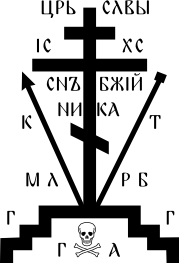Russian Orthodox cross
 Orthodox cross
|
 |
Greek cross
|
 |
The Russian Orthodox Cross (or just the Orthodox Cross by some Russian Orthodox traditions)[1] is a variation of the Christian cross since the 16th century in Russia, although it bears some similarity to a cross with a bottom crossbeam slanted the other way (upwards) found since the 6th century in the Byzantine Empire. The Russian Orthodox cross has three horizontal crossbeams, with the lowest one slanted downwards. Today it is a symbol of the Russian Orthodox Church[2][3][4] and a distinctive feature of the cultural landscape of Russia.[5] Other names for the symbol include the Russian cross, and Slavonic or Suppedaneum cross.
The earliest cross with a slanted footstool (pointing upwards, unlike the Russian cross) was introduced in the 6th century before the
One variant known as the Russian cross has only two horizontal crossbeams with the lower one slanted;[9] another is the cross over crescent variant.[10][11][6] Some Russian sources distinguish the Russian Orthodox cross from the Orthodox cross.[12] In Unicode the symbol (☦) is denoted as Orthodox cross.[13] The same USVA headstone emblem is called Russian Orthodox cross.[14]
Name
According to many sources[2][15][16] the name of the three beam slanted cross is Russian (Orthodox) cross (Russian: русский православный крест[3]).
Sometimes it is also called the Byzantine cross.[17] Alternatively, "Byzantine cross" is also the name for a Latin cross with outwardly spreading ends, as it was the most common cruciform in the Byzantine Empire. Other crosses (patriarchal cross, Russian Orthodox cross, etc.) are sometimes denominated as Byzantine crosses, as they also were used in Byzantine culture.
Sometimes it is also called just Orthodox cross.[18][19] At the same time the various Orthodox churches use different crosses, and any of them may be called an "Orthodox cross".[12] Moreover, there are no crosses universally acknowledged as "Orthodox" or "Catholic": each type is a feature of local tradition.[5] The cross has also been referred to as the "Eastern Cross," and "has a special place in Ukrainian religious life" and has been used by Ukrainian Orthodox and Byzantine Catholic churches.[20] For example, this particular cross is dates back to Kievan Rus', and is used by Ukrainian Catholics and Orthodox Christians.[21][22]
Meaning


The topmost of the three crossbeams represents Pilate's inscription which in the older
One variation of the Russian Cross is the 'Cross over Crescent', which is sometimes accompanied by "Gabriel perched on the top of the Cross blowing his trumpet."
Another variation is the monastic Calvary Cross, in which the cross is situated atop the hill of
Current usage
The Russian (Orthodox) cross is widely used by the
This cross is also found in Byzantine frescoes in churches now belonging to the Greek and Serbian Orthodox churches.[29] Also the Cross is used by the AIPCA churches in Kenya.
History
The slanted cross with three horizontal crossbeams existed already in the 6th century, long before the Great Schism. However, it was used only in church paintings, arts and crafts, and never on church domes.[citation needed] There are old frescoes depicting this type of cross in the regions of modern Greece and Serbia. One Byzantine icon featuring the three-bar cross, with the slanted crossbeam for the feet of Christ, is an 11th century mosaic of the resurrection.[30] The three-bar cross "existed very early in Byzantium, but was adopted by the Russian Orthodox Church and especially popularized in Slavic countries."[31]
At the end of the 15th century this cross started to be widely used in
In 1654, the Moscow council, erasing the vestiges of the canonical isolation of 1448–1589, coordinated Russian Orthodox liturgy with that of other Orthodox churches.
In the 19th and 20th centuries, the Russian Orthodox cross was promoted by the
The Russian Orthodox cross is depicted on emblems of several Russian ultra-nationalist organizations such as Brotherhood of Russian Truth and Russian National Unity.
Gallery
-
A 17th-century miniature of the Battle of Kulikovo (1380). A warrior bears a red banner with a cross
-
Ivan IV(the Terrible), 1577
-
Coat of arms of Russia from the seal ofFyodor I, 1589
-
Russian military flag, 1696–1699
-
Russian military flag, 1706
-
A copper cross typical forOld believers
-
A cross of aRussian Orthodoxpriest
-
A modern memorial to Ss. Cyril and Methodius in Khanty-Mansiysk, Russia
-
Coat of arms of Moscow Oblast, 2005
-
Coat of arms of Perm Krai, 2007
-
Sainte-Geneviève-des-Bois Russian Cemetery, the resting place of many eminent Russian émigrés
-
Białystok (Poland): Crosses on the domes of the Church of the Holy Spirit
-
Johnstown, Pennsylvania: Christ the Saviour Cathedral of the American Carpatho-Russian Orthodox Diocese (under the Ecumenical Patriarchate of Constantinople)
-
Svidník (Slovakia): Cross in front of a church
-
Flag of the Brotherhood of Russian Truth
-
Flag of RNU
-
USVA Headstone Emblem 5 "Russian Orthodox cross"
| Part of a series on the |
| Eastern Orthodox Church |
|---|
| Overview |
See also
References
- ^ "The Russian Orthodox Cross - Questions & Answers". www.oca.org. Retrieved 2021-07-03.
- ^ ISBN 978-91-972705-0-2.
- ^ a b Святейший Патриарх Московский и всея Руси Кирилл. Воздвижение Честного и Животворящего Креста Господня // Тихвинский листок №41, 27 Сентября 2017.
- ^ a b Фещин А. Довірся Хресту // Християнский голос. — 2002. — № 18 (2854). С. 232.
- ^ a b c Бурштын Я. Ірына Дубянецкая: Дзякуючы намаганням РПЦ пачынае мяняцца культурны ландшафт Беларусі (Фота і відэа) // Служба інфармацыі «ЕўраБеларусі», 16 ліпеня 2016 г.
- ^ ISBN 978-1-315-29011-9.
Thus the conquest of Kazan by Ivan the Terrible was also viewed as the triumph of Christianity over Islam, symbolized by the cross placed above the crescent atop Russian churches.
- ^ Русский крест: символика православного надглавного креста. — Москва, 2006. С. 149.
- ^ Мілаш Я. Традыцыі ўшанавання крыжа беларусамі ў канцы XIX ст. // Наша Вера. № 3 (65), 2013.
- ^ Рэлігія і царква на Беларусі: Энцыкл. даведнік — Мн.: БелЭн, 2001. С. 168.
- ^ a b Stevens, Thomas (1891). Through Russia on a Mustang. Cassell. p. 248. Retrieved 28 March 2014.
It seemed rather rough on Tartars, too, as showing scant consideration for the religious susceptibilities of a subject people, to find some of the domes of the Orthodox churches ornamented with devices proclaiming the triumph of the Cross over the Crescent. A favorite device is a Cross towering above a Crescent, with Gabriel perched on the top of the Cross blowing his trumpet.
- ^ a b "Russian Orthodox Church". Journal of South Asian and Middle Eastern Studies. 17: 4. 1993. Retrieved 20 May 2015.
Finally, the Russians, under Ivan the Terrible, defeated the Tatars in 1552 and firmly established Russian rule. In celebration of this conquest, the czar built two churches in the Moscow Kremlin and on the spires of the Church installed the Orthodox Cross over an upside down crescent, the symbol of Islam.
- ^ a b "Православные кресты: как разобраться в значениях" [Orthodox crosses: how to understand the meanings] (in Russian). 30 September 2011. Retrieved 21 February 2018.
- ^ Unicode Character 'ORTHODOX CROSS' (U+2626).
- ^ Available Emblems of Belief for Placement on Government Headstones and Markers, Supreme Court of the United States
- ISBN 978-0-313-34779-5.
- ^ Milo D. L. The Ankh: Key of Life. — Weiser Books, 2007. P. 13.
- ^ Becker U. The Continuum Encyclopedia of Symbols. — New York London, 2000. P. 71.
- ^ Chwalkowski F. Symbols in Arts, Religion and Culture: The Soul of Nature. — Cambridge Scholars Publishing, 2016. P. 112
- ^ "Why are we seeing orthodox crosses on Ukrainian Greek Catholic churches and literature? Is the orthodox cross allowed to be used?". Edmonton Eparchy. 2020-09-15. Retrieved 2021-07-03.
- ^ "View of Crosses of East Slavic Christianity among Ukrainians in Western Canada | Material Culture Review". journals.lib.unb.ca. Retrieved 2021-07-03.
- ^ "Why are we seeing orthodox crosses on Ukrainian Greek Catholic churches and literature? Is the orthodox cross allowed to be used?". Edmonton Eparchy. 2020-09-15. Retrieved 2021-07-03.
- ^ Communications, Eparchy (2020-09-15). "Why are we seeing orthodox crosses on Ukrainian Greek Catholic churches and literature? Is the orthodox cross allowed to be used?". Edmonton Eparchy. Retrieved 2024-01-30.
- ^ a b Яременко В. Золоте Слово: Хрестоматія літератури України-Русі епохи Середньовіччя IX—XV століть. Книга перша. — Київ: Аконіт, 2002. С. 485.
- ^ "Why Orthodox Christians see triumph in the cross". The Christian Century. Retrieved 2021-07-03.
- ISSN 1653-4212.
It would be convenient to characterize the relationship between Russia and Islam by its history of conquest and tension. After all, the emblem of the Orthodox Church is a cross on top on a crescent. It is said that this symbol was devised by Ivan the Terrible, after the conquest of the city of Kazan, as a symbol of the victory of Christianity over Islam through his soldiers.
- ^ "Church Building and Its Services". Orthodox World. Retrieved 28 March 2014.
Sometimes the bottoms of the Crosses found on Russian churches will be adorned with a crescent. In 1486, Tsar Ivan IV (the Terrible) conquered the city of Kazan which had been under the rule of Moslem Tatars, and in remembrance of this, he decreed that from henceforth the Islamic crescent be placed at the bottom of the Crosses to signify the victory of the Cross (Christianity) over the Crescent (Islam).
- ISBN 978-1-4051-8539-4.
- ^ "Cross, Orthodox | City of Grove Oklahoma". www.cityofgroveok.gov. Retrieved 2021-07-03.
- ^ Gerstel, Sharon (2006). "An Alternate View of the Late Byzantine Sanctuary Screen," in Thresholds of the Sacred: Art Historical, Archaeological, Liturgical and Theological Views on Religious Screens, East and West, ed. S. Gerstel. pp. 146–47.
- ^ "Imagery of Orthodox Easter | Vasileios Marinis and Martin Jean | Institute of Sacred Music". ism.yale.edu. Retrieved 2021-07-03.
- ^ "- The Cross". www.stgeorgecanton.org. Retrieved 2021-07-03.
- ^ a b Гнідець Р. Св. Хрест, його форма та різновиди в Україні // Греко-Католицька Традиція №9 (193), вересень 2013 р.
- ^ Белы А. Крыж Еўфрасінні Полацкай // Наша Слова. № 29 (817) 1 жнiўня 2007 г.
- ISBN 978-1-84176-925-7.
- ^ Мицик Ю. Московський Патріархат // Енциклопедія історії України : у 10 т. / редкол.: В. А. Смолій (голова) та ін. ; Інститут історії України НАН України. — К.: Наук. думка, 2010. — Т. 7 : Мл — О. С. 87.
- ^ Нуруллаев А. А. Нуруллаев А. Ал. Религия и политика. — М., 2006. С. 299.
- ^ Изотова О., Касперович Г., Гурко А., Бондарчик А. Кто живет в Беларуси. — Минск: «Беларуская навука», 2012. С. 740
- ^ Русский крест: символика православного надглавного креста. — Москва, 2006. С. 147.
- ^ Щербаківський В. Чи трираменний хрест із скісним підніжком – національний хрест України? // Визвольний шлях. — 1952, листопад. — Ч. 11 (62). С. 33—34.
- ^ Білокінь С. Українська форма хреста // Укр. слово. — 1994. — № 17 (2713).
External links
- "Explanation of the Three-Bar Cross". Church of the Nativity: Russian Orthodox Old Rite. Retrieved October 20, 2011.
- Kuznetsov, V. P. [Кузнецов В. П.] (1997). History of the development of the cross's forms. Short course of Orthodox staurography [История развития формы креста. Краткий курс православной ставрографии] (in Russian). Moscow.
{{cite book}}: CS1 maint: location missing publisher (link)

















